2012 JUN REGISTRATION 5 MITSUBISHI ROSA SUPER LONG BEAUTIES WILL COME TO OUR YARD IN MAY 2024
BE640J-XXX015, BE640J-XXX021, BE640J-XXX011, BE640J-XXX012, BE640J-XXX014 WILL BECOME AVAILABLE FOR EXPORT IN LATE PART MAY.2024. THE PICTURES ARE AS SHOWN BELOW.



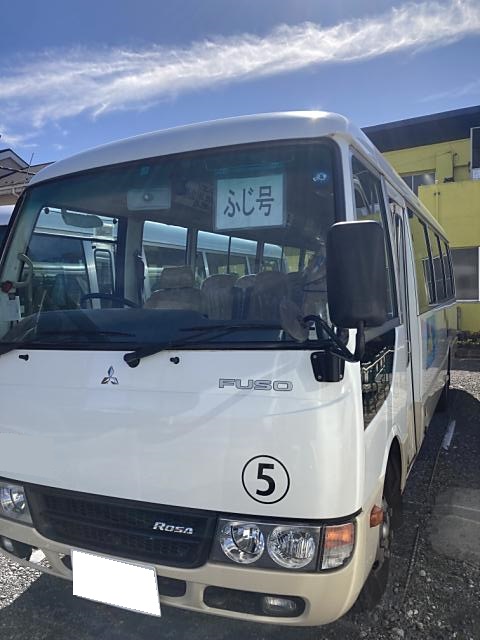

350807 ★2003 TOYOTA COASTER 1HD ENGINE AUTO HDB51 WILL ARRIVE AT OUR STOCK YARD
HDB51-XXX7224 KK-HDB51 will be available to export very soon. 29 seater with 81,000km mileage.
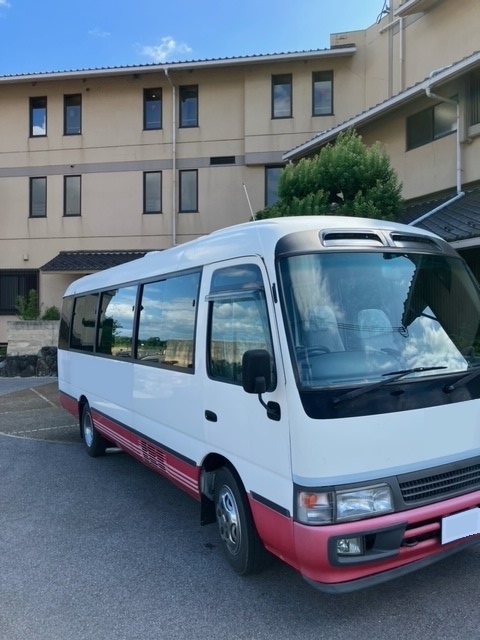
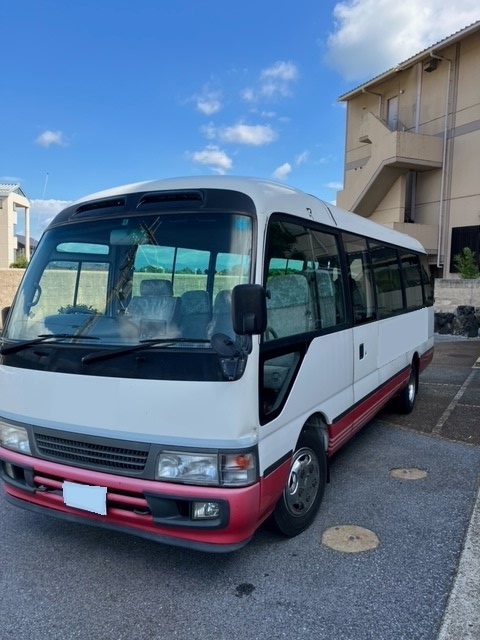
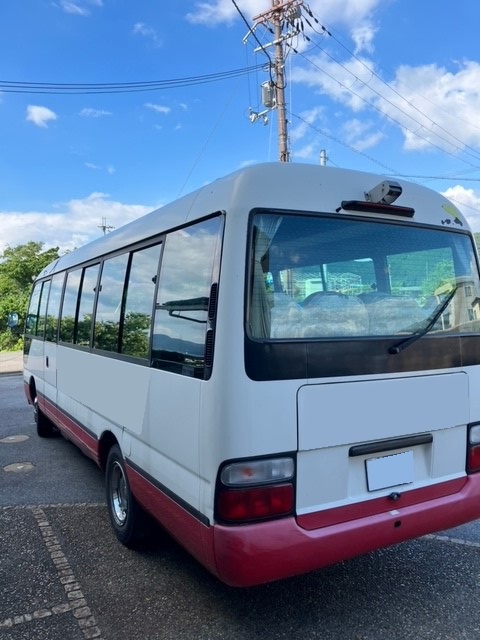
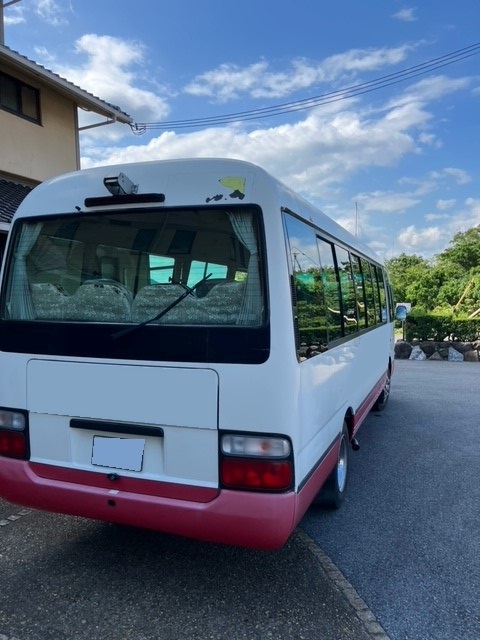



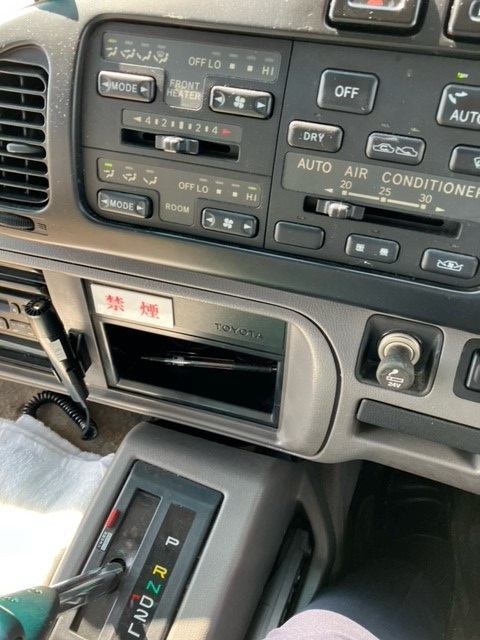
WE ARE TEAM AUTO GALAXY
We Auto Galaxy has 10 staffs overall. We are not a big company but good team work, The head office will close 11th to 16th AUG. as summer holiday.
But our factory is open during period for rental car customers. Also WhatsApp is always available.

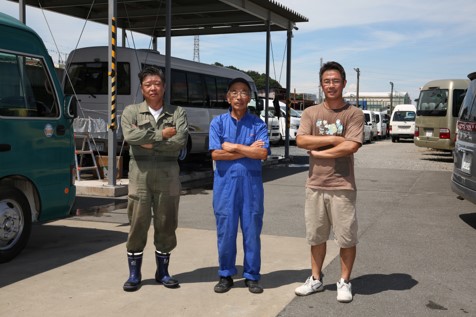
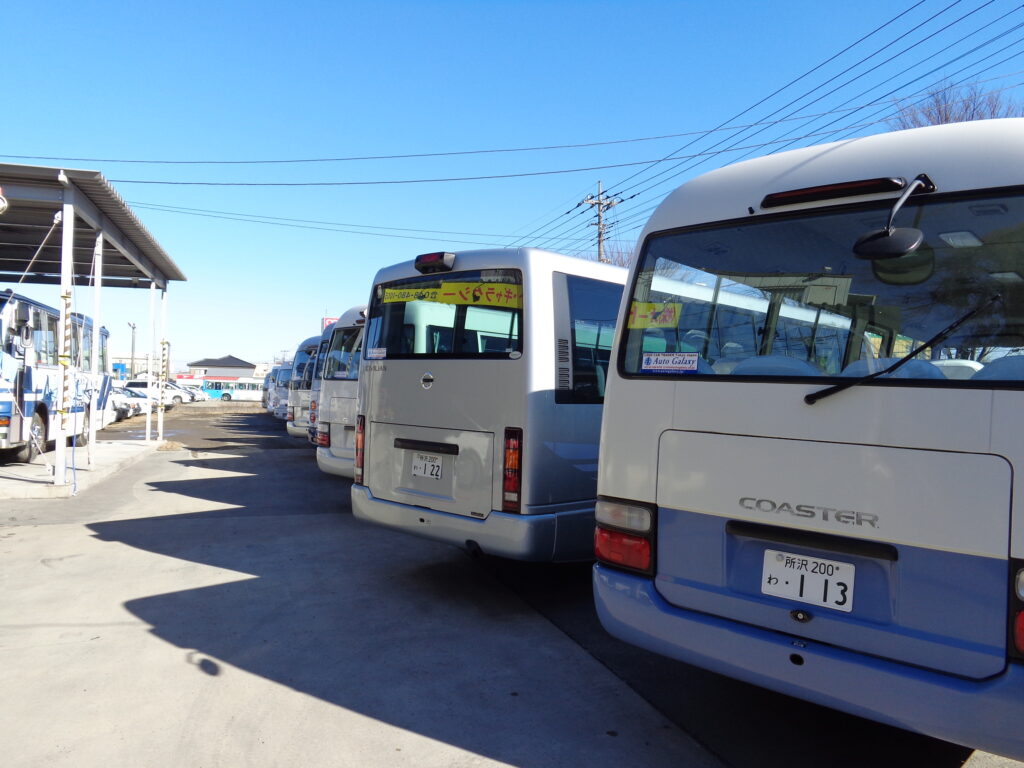
350513 NEW SMILING BEAUTY ★2014 COASTER LX N04C MT BECOMES AVAILABLE NOW
THIS IS THE MOST EXPENSIVE VEHICLE CURRENTLY WE HAVE IN STOCK. AND TOTAL MILEAGE IS 25,225KM.
WE ARE WAITING FOR YOUR FIRM ORDER.

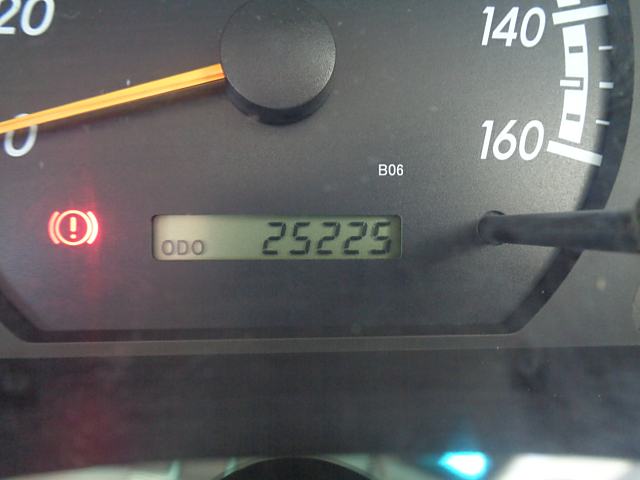

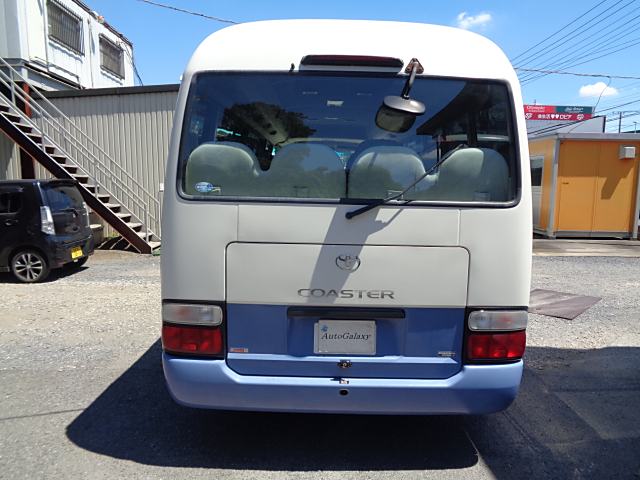
3 UNITS OF TOYOTA COASTER WITH 1HD ENGINE 6 SPEED MANUAL TRANS TO TANZANIA SINCE LAST DEC

We exported 3 units of Toyota Coaster 1HD engine with 6 speed manual transmission since last Dec to Tanzania. They were delivered to the same importer. They were modified splendid and wonderful special hire buses. Now the third one is waiting for paint work. We are microbus special list and especially strong to procure 1HD with 6 speed manual trans. Please check our export site frequently. Then you may have chance to get it.
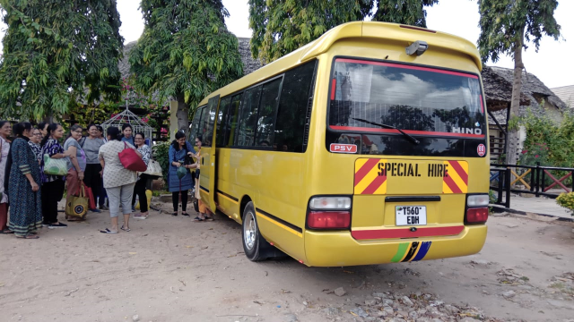

They are now really cool and fresh.
WE AUTO GALAXY’S STRONG POINT
WHY WE ARE STRONG. WE MADE OUR INTERNAL AD AS FOLLOWS.

6 NEW STOCKS WILL ARRIVE AT OUR YARD IN MID JULY 2023.
New stocks will be available around mid JUL.2023.They are 4 commuters and 1HZ Coaster and 4D34Rosa.


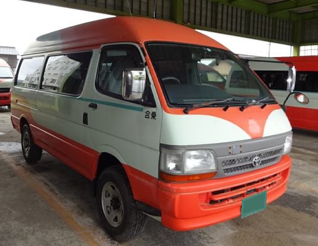



WE WILL HAVE ANOTHER 2 UNITS OF COASTER 1HD ENGINE MODELS IN STOCK THIS MAY.2023
Good news. We will introduce another 2 units of 1HD Toyota Coaster in stock this month.
FOB prices will be available soon.
①HDB51-XXX6300 2001/3 1HD 28 seater 270,000km AT Target FOB price US$17,985
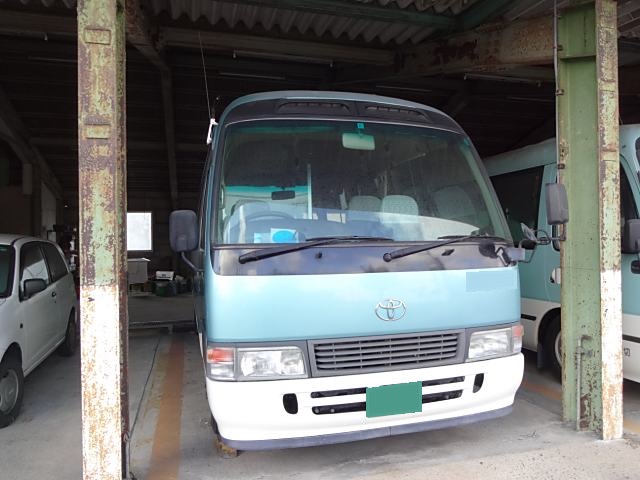
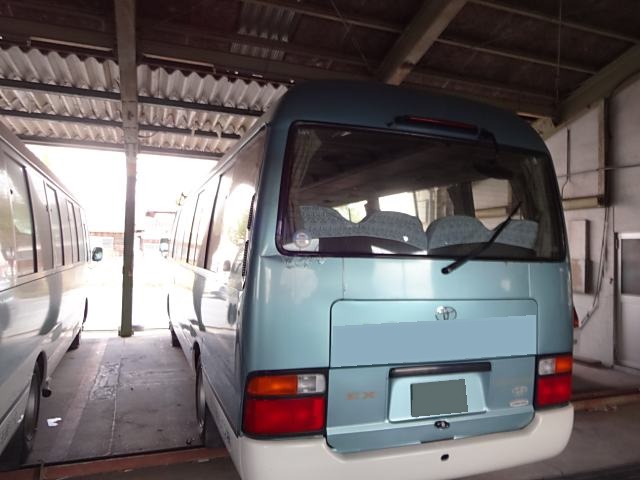


②HDB51-XXX6696 2002/5 1HD 29 seater 500,000km MT

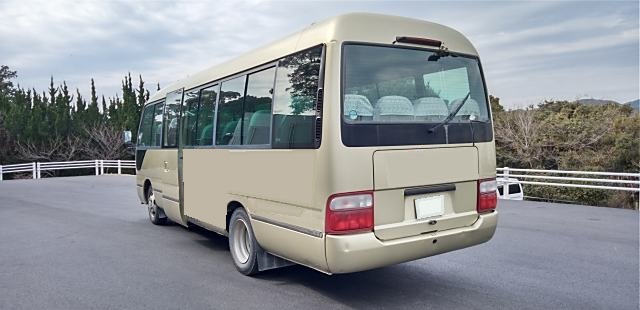


MID APR WE WILL HAVE HDB51 AND HDB51M 1HD IN STOCK
Last DEC we missed to purchase these two vehicles. But they will come to our stock yard mid this APR.
WE MADE IT.
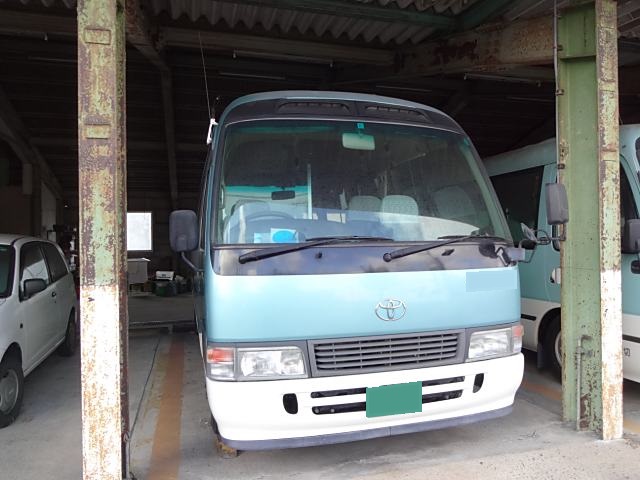
REF:350318 TOYOTA COASTER 2001/3 AT 28 SEATER HDB51-XXX6300

REF:350319 HINO LIESSE 2003/7 MT 29 SEATER HDB51-XXX0105
2023 NEW YEAR’S SPECIAL INTERVIEW FROM SBT CO.LTD JAPAN YOKOHAMA HEAD OFFICE
Last Friday 13th JAN.2023, We have special interview from SBT Co.Ltd Yokohama head ofiice KAITORE DIvision. We have almost 15 years business trading with SBT Co.Ltd in japan. Following materials written in Japanese will be dispatched all staffs in SBT. We hope English version maybe available soon.

DEAR TEAM AUTO GALAXY. THANK YOU.
Dear Sir
I am pleased to inform you that you sold us the best Toyota Coaster. I have bought five of them for this customer but according to him this bus was the best. I also congratulate you for the special service you gave us, you are very reliable, trustful and all the time you have updated me. Thank you again and please keep it up! will always recommend your name to other customers interested to buy cars from Japan, and will not hesitate to visit your website all the time to see if you have other good cars for my customers. The person you see near the car is the owner of this Mini Bus. He is proud of this bus and it is the best he has bought among the five he has.
We thank you again you have supplied the best Bus I would say. Thank you very much.
From Mr. O Natai, vehicle importer in Tanzania 2022/12/20

Because of too weak Japanese Yen, we will revise our FOB price effective from 18th OCT.2022. All models.
This price change is the 3rd time this year. Japanese government has no idea to recover Japanese Yen rate for more than 6 months.
The government has no strategy and also countermeasures.
We will become price competitive again. Now is the best time to buy stock vehicles from our site.
WhatsApp number of Auto Galaxy effective from 23rd Sep.2022 to worldwide customers
Today we are pleased to inform you of our WhatsApp number as shown below.
We are confident that we can do quick and effective communication with you all.
+819023908188
Best Regards
HELLO EVERYONE. WE WILL REVISE ALL FOB PRICES TOMORROW 9TH AUG.2022
We will become most competitive among Japanese used vehicle exporters.
Please check our new FOB prices. We will revise them tonight Japanese time.
WE WILL REVISE FOB PRICES OF MICROBUS FROM TOMORROW 24TH MAY.2022. PLEASE CHECK OUR NEW FOB PRICES.
We have decided to apply new FOB price for our all microbuses such as TOYOTA COASTER, MITSUBISHI ROSA and NISSAN CIVILIAN effective from tomorrow Japanese local time. Please check.
“Tsuyu” The Japanese Rainy Season
Every year from late May and into the month of June, Japan has its rainy season called ‘Tsuyu’. This covers the whole country, except Hokkaido, the northern part of Japan. The period leading up to the rainy season is known as ‘Tsuyu-iri’ and the end of the season is referred to as ‘Tsuyu-ake’. The distinguishing feature of the Japanese ‘Tsuyu’ compared to the damp feeling and the mist-like rain that falls every day. Due to this, we have to take care of damp and mould creeping into our houses and make sure our food stays dry to avoid the risk of food poisoning.
The word ‘Tsuyu’ is written with two characters, that for Japanese plum (梅) and rain (雨). This has led to several theories about the origin of the term. One of the most convincing theories comes from the fact that Japanese plums ‘ume’ ripen at this time of year.

Japanese Plums ‘ume’
Flower Of Plums
Japanese people take special care of ‘ume’ at this time of year, as they have special health-giving properties. Ume are said to protect people from the three well-known types of illness (Illnesses from food, problems of blood circulation and illnesses from the water we drink), so we consume plum alcohol and eat pickled plums. The red ‘shiso’ (a type of edible leaf) that we use in the pickling process is also particularly tasty around the ‘Tsuyu’ season.
When we were children, our packed lunches for school (often ‘Hi-no-Maru’ Bento – rice with a pickled plum in the centre which resembles the Japanese nationalflag
‘Hi-no-Maru)and our rice balls for school trips often had pickled plums in them.
Our Mums used to put them in for our health. Even when I go abroad now, I take pickled plums with me. They make a wonderful gift to Japanese people living abroad as a present from home.
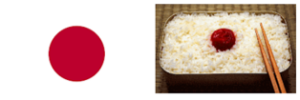
Japanese national flag/Hi-no-Maru bento

rice ball
In addition, ‘Tsuyu’ is a crucial period for fames for the planting of fruits, vegetables and various crops, because of the amount of rain that falls. In particular, ‘Tsuyu’ is the period for the toughest job of the year for framers, that of planting rice seeds. Even though this job is performed by machines now, traditionally the whole community would come together and form a line squatting in the rain water and spend a day planting seeds under the water line. This is a truly arduous task. We also have a festival in the community to pray for a good harvest of rice in the autumn. Since ancient times, these practices have strengthened ties in the community and promoted community sprit.

This festival includes special dance called ‘Bon-odori’. For this, adults, children and the elderly dance halfway into the night in times. This tradition is still alive today and even as an adult. I still feel nostalgic when I think of it. Thinking about it brings back many fond memories of childhood for me.

However, despite all this, most Japanese people dislike the ‘Tsuyu’ season. There are many reasons for this. Not only do we have to carry an umbrella everywhere with us and have to stay inside, it’s also a period when bacteria and mould can multiply. It’s a difficult to dry you washing and clothes can often become smelly because of the damp. For people like the Japanese who like to bathe everyday, ‘Tsuyu’ is an unpleasant season as we can normally have dry clothes to change into after bathing. However, some Japanese people like to relieve stress by admiring the rare flowers such as hydrangea and iris that only bloom over ‘Tsuyu’ period.
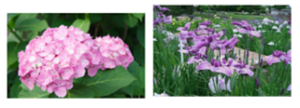
hydrangea and iris
Finally, when this ‘Tsuyu’ period comes to an end, Japan starts to experience its hot summer.
Kazumasa Mizue
President
Auto Galaxy Co., Ltd.
This is Mr. Seiichi Shioi your counter partner
I am still one finger typewriter. This is the latest You Tube movie without my voice.
Please trust us.
This is our stock yard in Saitama prefecture
Currently we have 3 stock yard in Saitama Auto Center.
【Stock yard no.1】
【Stock yard no.2】
【Stock yard no.3】It is now under contruction.
Snap Shot JAN.2022 in the morning of Auto Galaxy’s head office
We have started regular work from yesterday. We had first snow last night. This is sample movie of our head office early in the morning.
We will create You Tube movies of our all stock vehicles in order for you to check and confirm their conditions.
Please switch on Subtitles and review.
Merry Xmas and happy new year
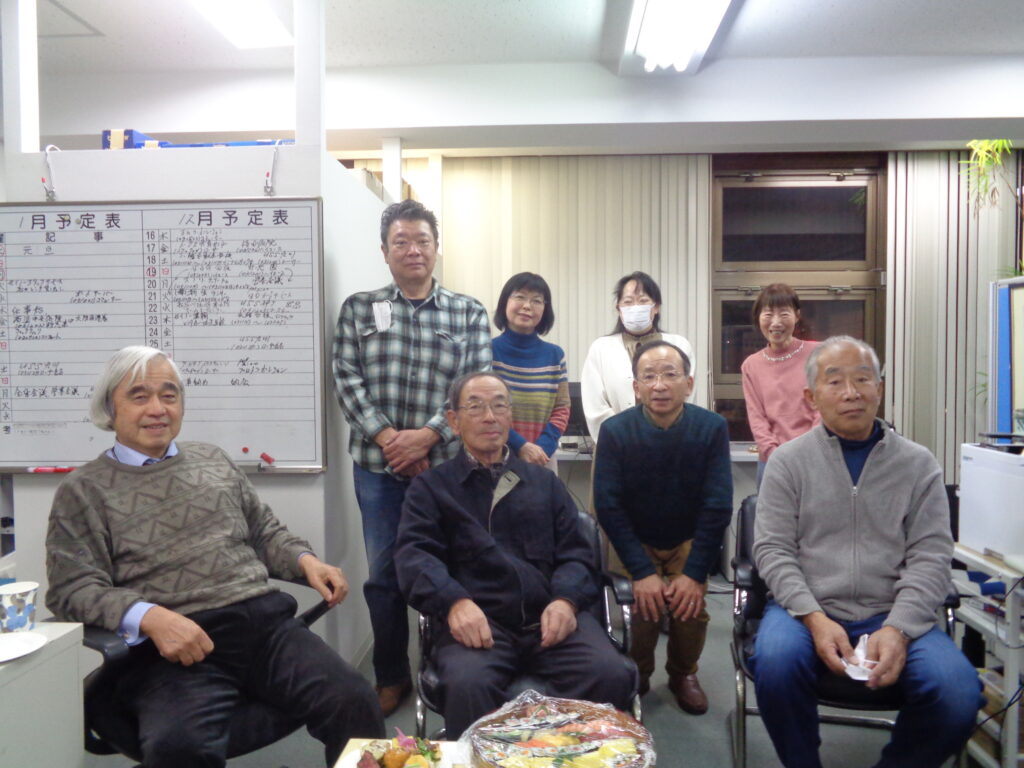

We will close our head office from this evening 28th to 5th Jan.2022 as new year holiday.
Our new staff
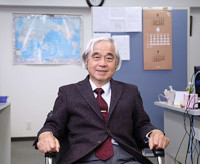
Dear Sir or Madam,
We would like to introduce our new staff
who is responsible for overseas market as follows.
Best regards
Kazumasa Mizue CEO
New staff
Seiichi Shioi
General Manager of Overseas Sales
Auto Galaxy Co., Ltd.
2F 2-30-20 Sakae cho, Higashi-Murayama city
Tokyo, Japan 189-0013
Phone: +81 42396 8118 Fax: +81 42396 5828
info@autogalaxy.co.jp
https://autogalaxy.tokyo/
Shirakawa-Go and Gokayama
Shirakawa-go and Gokayama were listed as World Culural Heritage site in December 1995 for their uniqe style of architecture, found only in this region.
They are located in Hidaka mountain range, the backbone of the Japanese Islands, and on the east side of Hakusan National Park. They are very heavy snowfall and were therefor so called Solitary Islands. However they became to be known for its their architecture with with distindtively shloped roofing “Gasho-zukuri”.
Speaking of world cultural heritage sites, the most people imagine the unimaginably ancient building such as Peru’s Machu Picchu, Cambodia’s Angkor Wat, and the Great Wall of China. However, the surprinsing thing about the Shirakawa-go world heritage site is that it looks just like a typical Japanese countryside area.

“Gasho-zukuri” is the construction style with steeply roofs like putting ones hands together. It is built with a style called “gabled roof architecture with principal ridgepole” in wich the both end of the roof are like a open the book. It is built to endure a large quantity of snow normal for this region. Metal iron clamps and nails are not used for the joining of building materials, instead wooden wedge and neso, young branches of the Japanese witch hazel.
The gabled roof has an almost 60 degrees incline to shed heavy snow.There is Gasho-zukuri house that is 5 stories high. When you enter inside, you will see one giant Hinoki” pillar more than 150 years old and length approximately 11 meter long, going through up to the roof. Also you notice the many beams built with Katsura, Chestnut, and Zelkova wood, approximately 300 old years, everywhere.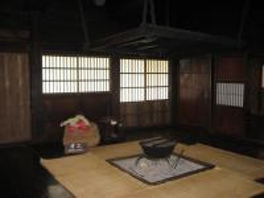
There is the hearth in the center of living room. The smoke from the hearth which comes up to the ceiling makes building wood materials glossy. This smoke is useful for insecticide and prevention of decay. The hearth is used as the lighting for cooking and air-conditioning. This smoke makes the building wood materials strong as metal.
In the village of Shirakawa, the Sericulture business was main industry. They used the huge space under the roof as the manufacturing facility of Cocoon which was used for making silk.
Once at every 40 to 50 years, they change the straw on the roof. They have the way of helping each other, called “Musubi”, the village bond. More than 100 to 200 villagers gather to do it.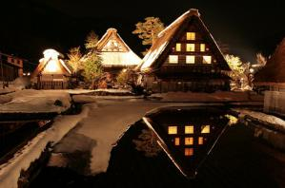
Bruno Julius Florian Taut once praised the architecture in Shirakawa village for its extremely logical and functional design, saying he had never seen anything like it anywhere else in Japan.
Nowadays, we Japanese still have the spirit of “Kizuna” (Bond) in our blood. When the great earthquake disaster hit the North-East of Japan, the news told of many people helping each other in the midest of such great confusion.
I understand that the origin of Japanese life and the spirit of bond might be the reason that Shirakawa volost was listed as par of the world cultural heritage site.
Kazumasa Mizue
October in Japan
October in Japan
We call October by it’s traditional name ‘神無月 Kannazuki’. It can be literally translated as “the month when there are no gods”. The gods of Japan left their shrines and visit annually at Izumo Taisha(One of the famous shrines in Totsutori Pref. located in the southern part of Japan. There the month was known as ‘神在月 Kamiarizuki,’the month when the gods are present.
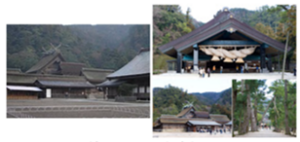
Izumo Taisha/Main Shrine
Japanese food in October is very delicious. These food especially vegetables, fruits and fish are very tasty and nutritious.
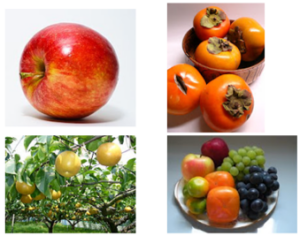
Apple・Persimmon・Pear・Autumu Fruit

Shitake/Matsutake Mushroom
Sanma(Saury) is great. We cook it traditionally on the barbecue grill out side of our houses. We make wind with fins would the smoke of the Sanma would fill up the town and its smell make us hungry. That’s the typical view in October in Japan. Today in Japan, we use modern way to cook inside of our houses and can not smell the Sanma cooking.
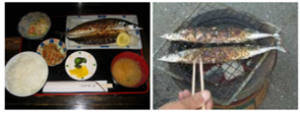
Saury set menu/Saury to roast with hithirin
We eat fresh fish with ‘Wasabi’ Japanese horseradish and ‘Soy sauce’. Today even China and other Asian countries like to have fish this way. That is why the Tuna fish has become rare though international limitation. However, Japanese has successfully created Tuna fish farms. It takes five to six years after hatching to become a 200 kg great Tuna fish.
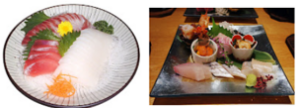
Sashimi(home usu)/Sashimi(For Party)

Culture of tunas
We have only one national holiday in October. That is Sport Day on 10th of October. The Olympics were held in Tokyo on the 10th of October in 1964.

Tokyo Olympics in 1964
Since this event, the 10th of October has been celebrated by Japanese people as a holiday for the practice of sport. Therefore, around the 10th of October on a Sunday, elementary schools across Japan hold sports days.

Sport Days Festybal
The whole family and the neighbors will come to the school from the early morning to cheer on and support the children. Mothers bring packed lunches and rice balls that they have made the night before, with treats such as Japanese oranges, persimmon fruit, chestnuts, pears and grapes that are specialties of autumn.
This is Japanese October
Kazumasa Mizue
President
Auto Galaxy Co., Ltd.
The Japanese Hot Summer Part2
Hot summer!!
Until now, every offices and classrooms are cooled down by air-conditioning and we had very comfortable way of life. However, this summer is different. We had a big earthquake on 11th March, the nuclear power plant in Fukushima was hit by a kind of the tsunami which we never had before. It has been broke down since then and we have had electrical power shortages.
This summer, all households and companies must cut down the use of electricity to avoid a major black out.
Before we had air-conditioning in Japan, we just coped with the heat. For example, we used wind chimes that make us feel like the wind is blowing. This is all so the same as the sound of river water and the song of birds. These kinds of natural sounds make us feel more relaxed.

Wind Chime
We have many firework festivals all over Japan in summer time. A lot of people go and enjoy the great feast of fireworks. We have these firework displays on beaches and next to rivers. It feels a lot cooler at these places than in the city.

Fireworks
We have foods for summer time too. A typical summer food is water-melon.
Before we had refrigerators, we put the whole water-melon in the cold water of a well or a spring. We enjoy putting a little bit of salt on the watermelon to make it sweeter.
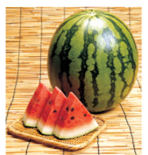
Watermelon
The shaved ice with syrup flavored with melon, lemon, strawberry etc make hot bodies cool and forget the heat of summer whilst wearing summer wear such as ‘Yukata’ made with good quality a Japanese silk.
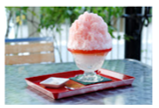
Shavet ice

with Yukata
We should not to forget ‘Hiyashi-somen’. It is a kind of thin noodle boiled and then cooled by ice water. Japanese love it with tomatoes, cucumbers, water-melons, cherries and etc. Cooled ‘Hiyashi-somen’ is the best summer food for hot summer in Japan.

Hiyashi-somen and relish/somen with cucumber
We have a traditional way to eat ‘Hiyashi-somen’ and called ‘Nagashi Somen’,
‘Nagashi Somen’ is when somen is put in flowing water in a bamboo gutter. You catch the somen with chopsticks, dip it into ‘somen-tsuyu’, kind of soup for somen, and eat it. ‘Nagashi Somen’ is one of outdoor entertainments and you will have fun time and also cool taste of summer.
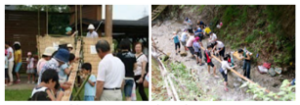
Nagashi somen/The outdoors
We used to have a variety of ways to be cool in hot summer in Japan since ancient times.
We must reduce electricity consumption by 15 % this year. However, that is not the final solution. We will, and shall find the new energy, instead of depending on nuclear power. There are some new way of making energy by earth-heat, wind, solar and ocean waves. In the near future, we Japanese will create the new clean source of energy that will shake the whole world.
We are used to disasters in Japan. We have become resilient and know how to overcome such problems.
Kazumasa Mizue
President
Auto Galaxy Co., Ltd.
“Minazuki”
Another name for June is ‘Minazuki’ means the month of water.
In June in Japan, Japanese farmers put water in their rice fields which is why we call the month of June ‘Minazuki’ During this time of year, we have the rain almost everyday till middle of July.

Taue
Most people can not play any sports or go for picnic outside. However, some people do go out with their umbrella to view the flowers such as hydrangeas, iris, lily which represent the rainy season.
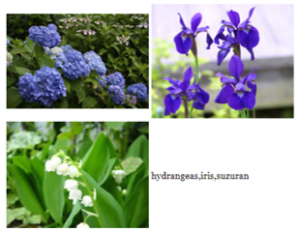
hydrangeas,iris,suzuran
Hakone Gora and Satte, Saitama Prefecture is famous for hydrangeas. You can view these flowers from the train or at the flower festival respectively.

Hakone Gora/Satte in Saitama Prefecture
The Kitayama Park in Higashimurayama city where our company Auto Galaxy’s main office is, is iris garden is famous for its iris garden.
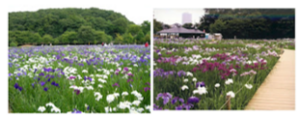
Kitayama Park
At this time of year in June, the grocery store are filled with a variety of seasonal vegetables, fruits, bamboo shoots, soybeans, biwa, peaches, plume, melons, etc.

grocery store
For beer lovers, boiled soy beans, bamboo shoots and bacon asparagus are the most popular foods and they sometimes drink too much.

soy beans

cooking of bamboo
Soy beans has many mineral within such as vitamins A, B1, B2, caladium and protein.
They are good for cholesterol, cancer prevention and. improving cardiac function,
Japanese farmers are trying to produce many kinds of seasonal vegetables and fruits for breeding better nutritious foods every day.
Those who love to cook also trying to improve and make their food more delicious and nutritious. They publish their cook books and become best sellers in Japan.

cook book/cooking school
However, now in Japan, many parents at work can not cook at home. Fast food and instant food are very popular. Gyudon (beef bowl) is popular Japanese fast food and its chain stores sell it at 250 Japanese yen and annually turnover is more than 700 million yen.

Cupnoodle/beef bowl
Kazumasa Mizue
President
Auto Galaxy Co., Ltd.
Japan in April
Everything starts in April in Japan.
Most of Japanese people remember their entrance ceremonies, especially the one for elementary school more than for kindergarten, middle school, high school or university.

Entrance ceremony
Everywhere in Japan, children aged six are held by hand by the young their mothers and enter the elementary school gates covered with cherry blossom.

Entrance ceremony of elementary school
They have both expectation and fear of thing happening around them for the first time.
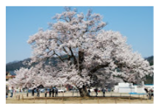
cherry blossom
The day before, the mother writes her son’s name on his new school goods, excise books, notebooks, eraser even a pencil and satchel the grandfather bought with care. This is to ensure they are not mixed up with those of other children.
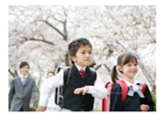
with schoolchild’s satchel
They change their shoes to indoor shoes to enter the classroom where the teacher welcomes them and shows them their seat.
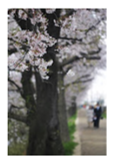
cherry blossom and elementary school
After few days of going to school, they become close friends with one another. In the classroom, they choosing class representative and form a small community.
The most different thing between kindergarten and elementary school is that the parents do not take their children to kindergarten nor pick up them.
Usually elder boys and girls make a group, two to ten children, and escort younger children to the school with them. And there are lollipop ladies at the pedestrian crossings to make sure children can safely cross the road by raising their right hands.
Children have homework every day; addition, subtraction and how to write Japanese with two different forms, ’ Katakana’ and ‘Hiragana’.
If they don’t do their homework, the next day at school, the destiny of standing alone in the hall way is waiting. This is the most embarrassing moment for a boy when a girl who he likes sees him standing for punishment.
After six years at elementary school, also in April, they have the entrance ceremony for junior high school. This is conducted over a larger area and because more children come to the junior high school. They have more friends.
All student both boys and girls wear the same black uniform. It is very difficult to know who is who.
At junior high school, the senior students invite the new ones to join the sports and extra-curricular activities. Half of the new students join the clubs, however, a large number of them will quit because they want to be independent.
And again after three years at junior high school also in April, they will graduate and go to high school.
In foreign countries such as Australia and New Zealand, they graduate in January or February, but in September in USA, Canada, Great Britain and France. They do not have entrance ceremonies like in Japan. They just have welcome parties.

foreign countries graduate

Not only do Japanese schools start in April, every company in Japan welcomes new workers in April too.
we do study for examination to enter a good school ,the good company
In Japan, most important things start in April.
Kazumasa Mizue
President
Auto Galaxy Co., Ltd.
Hina Matsuri The Japanese “Doll Festival” for the girls
Hina Matsuri takes place on 3rd of March and celebrates “Girls’ Day”. This is the day families pray for the happiness and prosperity of their girls and to help ensure that they grow up healthy and beautiful. The celebration takes place at every home which has daughters and meant to ward off evil spirits from girls.

A male doll and the female doll
A display of dolls.
The family will also decorate the display with hishi-mochi, sweet liquor, and peach flowers.
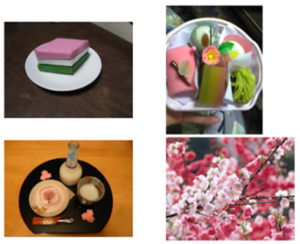
Hishi-mochi・Sweet liquor・peach flowers
However, few houses these days have enough space to place Hina dolls so many just decorate their homes with hishi-mochi, liquor, and flower. All these decorations must all be cleaned away on the 4th of March. Failure to do this will mean that the family’s daughters will not find husbands with later in life.

A display of dolls
1)Hishi-mochi
These are diamond-shaped mochi arranged in three layers. The layers are different colors, pink, white and green going from top to bottom. This represents the image of peach flowers sprouting up through the snow.

Hishi-mochi
2)Sweet liquor
For Japanese people, the combination of re and white means happiness. White, sweet liquor is placed around the house next to the red peach flowers to complete this combination and create an atmosphere of happiness.

Sweet liquor
Chirashi-sushi and soup of the clams are well edible by events of the Doll’s Festival.

Chirashi-sushi and soup of the clams
Kazumasa Mizue
President
Auto Galaxy Co., Ltd.
Setsubun
Setsubun is a special name for the 3rd of February. It dates from the Heian Period as a practice to drive away demons and evil spirits.

Setsubun Festival
This practice was adopted by ordinary people later in the Muromachi Period.
On the evening of February the 3rd, which is the coldest day of the year, people skewer the heads of barbecued sardines on a tree branch and place them over the windows and entrances of their houses.

sardines and Hiiragi
The bad smell is intended to drive evil spirits always. One of the men of the family will wear a demon’s mask and the whole family will throw roasted soy beans at him shouting ‘Demons out, happiness come in’. The soy beans that have been thrown are them eaten with everyone eating their age plus one.
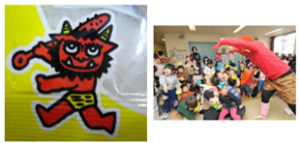
Demons out,happiness come in!!
Soy beans destroy evil magic and throwing them as a family is a prayer for a year without sickness for the family members. After this, the family will all eat a special kind of rolled sushi in silence while making their own wishes. They eat facing south south east or to the right (the direction changes every year.)
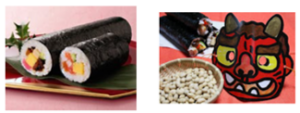
rolled sushi,south south east(this year)
Setsubun is not just for the family, it is also held in schools and nursery schools. This becomes a fond memory for all the children.
In recent years, celibates and sports players have appeared at shrines and temples to join in the beast throwing.

famous people beast throwing
In Japan, we have four seasons. Setsubun has a meaning of marking the change in seasons and the word is also used to refer to the period before the season’s change.

Red Demons’mask
Kazumasa Mizue
President
Auto Galaxy Co., Ltd.
O-shougatsu in Japan
Each family decorates the entrance halls of their houses with pine branches and other ornaments. As most companies shut down for a week or so following the end of the year, most people spend some quiet time with their families.

pine branches
Most children get up early on New Year’s Day and wish their parents and grandparents a ‘Happy New Year’. After this, they receive some ‘New Year’s money’ in an envelope from their fathers and grandfathers. How much they get depends on their age but they might get anything from 1,000 to 10,000 yen. As the children can use this money for whatever they want and it is their only chance to get money, it’s a truly special thing to them. For families of high social status, New Year’s is a time when many people come to the house to say ‘Happy New Year’. The children in these houses can also get New Year’s money from these visitors so they can really rake it in’.
New Year’s money
We call the 1st of January ‘Gantan’ and the first thing everyone does in the morning is open their postboxes. This is because they are expecting New Year’s greetings cards from friends, acquaintances and people they have helped throughout the year.
After checking their postboxes and giving the children their money, the whole family get together and have ‘Ozoni’ which is a New Year’s soup and make the first trip of the year to a shrine or temple to pray. Many people put some money in the collection box as a make of gratitude for the past year and to pray for health and the security of the family, happy marriages, success in exams and businesses and so on. People pray for whatever they want.

Naritasan
Kawasaki daishi

Meijijinngu
On the 7th of January, we eat rice porridge with seven vegetables to pray that our family will see no illness, disaster or accidents. This also senses to support the stomach as many people will have eaten too much over the holiday period. Also, the 11th of January is another special day when the rice cakes that have been placed out as decoration over the holiday period are broken with a hammer and cooked.

mochituki

kagamimochi ozoni
The country starts moving again on the 4th of January, with civil servants and company employees returning to work.
Kazumasa Mizue
December is a busy month for the Japanese
In Japan, December is informally known as ‘Shi-hasu.’ This expression, meaning ‘Running teacher’ gets its name from the notion that everyone is busy, even teachers who usually have life quite easy, are rushing around. We also mark December the 31st as a day for finishing up the left-over jobs for the year and getting ready for the coming New Year. This is all because these customs have been in place for a long time.
Merchants all over Japan see December as an opportunity to make the biggest profits of the year. Christmas songs and jingles resound on shopping streets and department stores. One important custom at the end of the year is to give gifts known as ‘Oseibo’ to our bosses and companies with whom we have done business. These gifts are mainly food which people can enjoy over the New Year’s period.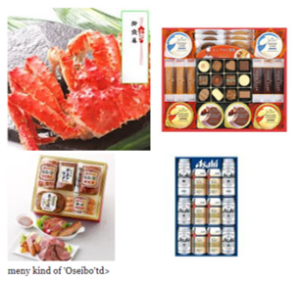
The New Year’s period is also important for ‘Year’s End Parties’ with friends and colleagues as a chance to reflect upon the year’s highs and lows. People go to hotels and such. As Japanese people have a particular fondness for this kind of get together it happens all year round but there is a special bonus in.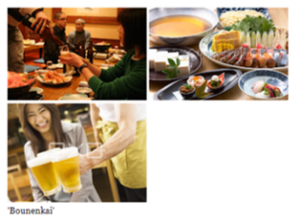
December for employees and people has lots of informal and casual parties with different groups of friends. Families let each other do their own thing at this time of year as parties have been the done thing for a long time. After these parties, even when the hangovers have not eased off, the big clean-ups of the house and office begin. This is a special clean-up, designed to draw a line under the passing year and let us begin the new one with a clean slate and the whole family and company pitches in and works together as equals.
January 1st makes the start of the longest holiday of the year; companies pull together and set lofty targets aiming to beat the sales of the previous year. Of course, along with sales an accumulation of capital funds is expected. This is really tough in Japan. The majority of smaller companies with less than 50 employees are straggling with debts and in the red.
For this reason, the people who cannot pay debts off by the end of the year go round hanging their heads and there are always a number of people who commit suicide under this pressure at the end of the year. The end of the year also has the highest frequency of bag snatching incidents and robberies. However, once we pass the 31st of December, lender ease off and do not chase up payments until the middle of January.
This means that borrowers can take it easy over the New Year’s period.
Ordinary Japanese people listen to the sound of the ringing temple bells and eat ‘New Year’s noodles’ on the 31st of December and watch game shows on TV with the family.
With regard to ‘New Year’s noodles’, they are chosen as a special food because they are easy to cut and this goes with the image of cutting away the bad things of the previous year and welcoming the new. The temple bells are struck in temples all across Japan 108 times as according to Buddhism, this is the number of worldly desires that are in men’s souls and striking the bells drives away. People pray before the bell and after ringing it 107 times, the 108th is to see in the New Year. 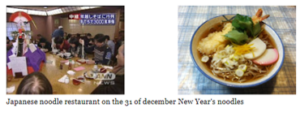
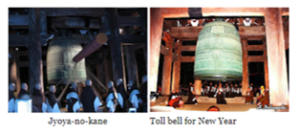
We also have the ‘Red and White Singing Contest.’ The national television station gathers male and female chorus members from all over Japan and splits them into 25 male groups and 25 female groups as red and white respectively. Men across Japan support the men in white while ladies support the girl in red. The contest lasts for 2 hours and 45 minutes. This contest was first held in 1945 with the famous personality Furukawa Rappa and actress Mizonoe Takiko presenting the show. This came just months after Japan’s defeat in the War and was intended to lift the spirits of the downcast Japanese people. As of now, it is now in it’s 65th year and is hugely popular.

In the last ten days of December, butchers, fishmonger, grocers and the like lower their prices to shift the stock that is left as it will cause a loss if it goes unsold by the end of the year.

Usually, housewives buy in lots of food to see the family through the long holiday and makes lots of food that can be kept to feed the family and any visitors over the holiday. 
“Shichi,go,san”
In November, there are special ceremonies to pray for the good health of children turning 7, 5 or 3 in each year, this is known as ‘shichi, go, san’ or 7, 5, 3.
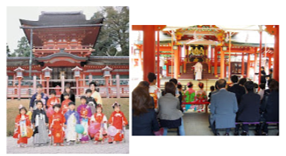
shrine or temple to pray
For boys, there are ceremonies at the ages of 3 and 5 and 3 and 7 for girls, all held on November the 15th.
This is one of our annual customs that takes us to a shrine or temple to pray for prosperity. In the old calendar, the 15th of November was traditionally a day when evil spirits and demons would not roam, therefore everything bring happiness and joy.
In addition, November in the old calendar was the time when the harvest was already completed and people would give thanks to the Gods for the food they have received. This giving of thanks would fall on the 15th which is the full moon of the month and people would give thanks for the growth of their children as well as the harvest.
Children of 3 let their hair grow long, at 5 years old they wear traditional Japanese trousers (hakama) for the first time and at age 7, this changes to a formal kimono outfit with a sash befitting an admit as a rite of passage. In many regions, 7, 5, 3 are viewed as happy occasions which concede with milestones in a child’s development, learning language at 3, growing in intelligence at 5 and giving adult teeth at 7.

七・五・三 formal kimono・・
In modern times, for new, young mothers and fathers, 7, 5, 3 is a time when they consult their parents as to which shops are good for the children’s clothes, which shrines to go to etc. This makes the events a truly special occasion for the whole family.
This is the first time for the children of each family to wear hakama and the first chance for girls to wear make up and go to a shrine.
On the way home, the family will buy special sweets (chitose-ame) and stop at a photograph studio for a commemorative photograph of the day, maybe stopping at a restaurant for dinner last. Of course, the parents are careful not to let their children get their beautiful clothes dirty at dinner.

chitose-ame/restaurant for dinner
All in all, 7, 5, 3 gives us memories that we treats are forever.
Kazumasa Mizue
President
Auto Galaxy Co., Ltd.
“The Sports Day” In Japan, the 10th of October is sports day
The Olympics were held in Tokyo on the 10th of October in 1964. At these games, Japan was particularly strong in volleyball, gymnastics, judo and wrestling, taking 16 golds, 5 silvers and 8 bronzes medals. The total number of medals taken was 29, putting Japan in 3rd place in the medal league after America and Russia. Since this event, the 10th of October has been celebrated by Japanese people as a holiday for the practice of sport.

Tokyo Olympics in 1964
Therefore, around the 10th of October on a Sunday, elementary schools across Japan hold sports days. The whole family and the neighbors will come to the school from the early morning to cheer on and support the children. Mothers bring packed lunches and rice balls that they have made the night before, with treats such as Japanese oranges, persimmon fruit, chestnuts, pears and grapes that are specialties of autumn.

Japanese autumn fruits

Lunchbox
Traditionally, a tent is set up in the center of the ground and a edges of this track that the supporters sit round and cheer on the children with all energy while eating, drinking and having a good time
All the students are split into one of two teams, the red team or the white team and compete in a variety of events including a tug of war, on-the-shoulders jousting and a running bread-eating contest. Representatives are chosen from each class to compete in a relay. The class members and best friends of these representatives lose their voices cheering on the students in these races. The runners feel increasingly nervous as the race approaches and they truly appreciate the support of their friends. The nervous are at their worst when the runners make eye contact with their friends and relatives watching from their seats. For many children this is their fist experience of competition.
The children all try their very best, all the while slipping, falling and getting covered in grazes. After the events are finished, everyone heads for home. On the way, the winners of the races swagger and boast about their victories and those who lost make excuses to their friends. The conversations about the day that take place around the dinner table are lovely and fun for the whole family.

Sport Day’s Events
The following day is a day off for the children. Sports days are held for children from the age 3 or 4 in nursing schools, throughout elementary, junior high, high school and university. The liveliest events are believed to be those held at elementary schools as they are great for the children and the whole family.
All Japanese people have found memories of their sports days when they were children.

Kazumasa Mizue
President
Auto Galaxy Co., Ltd.
“O-tsuki-mi” We Japanese love to watch the moon on 15th September
In Japan, we have four seasons (Spring, Summer, Autumn and Winter). We change our clothes to fit the season, with short-sleeved shirts for summer and long-sleeved shirts for spring and autumn. In winter we wear coats. We have a good sense of fashion and love to change our clothes to suit the different seasons. In each season, different flowers bloom. Some people love to plant seasonal flowers and to go to the suburbs to see beautiful flowers and trees with friends.
In the night of the 15th of September is revel as having the most beautiful night sky of the whole year. You can see the moon and even distant stars. The 15th of September offers us a full, mid-Autumn moon that is the most beautiful moon of the year, known as the ‘heaviest moon’ or the ‘full moon of the 15th’. A common fairy tale states that a giant rabbit live in the moon, beating ‘mochi’ or soft rice cake.

This custom crossed to Japan from China. In China, there has been a festival known as “Chu-shu-setsu” since the Tang era which makes the autumnal equinox. This custom came from China to Japan between the Nara and Heian era and took root in Japanese culture. Noble families would elegantly observe the reflection of the moon in the water of a lake from a small boat they would cast out. They would compose poems on the moons’ beauty.

O-tsuki-mi is a significant event in that it involves offering thanks for the harvest taken in during September. We make an offering to God of Taro potatoes that have been steamed in their skins; this is the reason for calling the 15th September ‘Imo-Meigetsu’ a reference to harvested potatoes.

The 13th of October of the old calendar is known as ‘Ju-san-ya’, the moon of 13th of October. This is another night on which it is customary to watch the moon. Other days to watch the moon include ‘Nagori-no-tsuki’ and ‘Ato-no-tsuki’, on these days beans and chestnuts are offered instead of taro potatoes.
On both the 15th of September and the 13th of October, we place a stand on the balcony or porch of our houses. We offer dumplings and seven kinds of autumn weeds, Eupatorium, Ominaeshi, Ivy, Bush clover, Chinese bellflower, Pink and Arista.
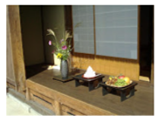
If you look at the moon just once on either the 13th or 15th, it is very bad luck and is known as ‘Katami-zuki’. We always watch the moon on the 13th and 15th for good luck and a plentiful harvest. This festival shows the mysterious nature of the moon within Japanese culture.

Kazumasa Mizue
President
Auto Galaxy Co., Ltd.
The Japanese Hot Summer Part1
Summer in the country of Japan, a nation surrounded by oceans on all four sides.
Out of the 47 prefectures that make up Japan, only 8 are landlocked.
(群馬県・栃木県・埼玉県・山梨県・長野県・岐阜県・滋賀県・奈良県の8県。)
Schools in Japan closed for over 40 days as a summer vacation and most people working in the private sector received between 5 to 10 holidays.
The summer vacation offers us a chance to visit family in our home towns or take trips. Of cause, due to the high volume of traffic on the highways, traffic is often slowed to a crawl. It can take between 6 and 8 to cover distance that would normally take one hour.

heavy traffic
Naturally, most families and young people head to the beach. Most people rent beach huts or lay sheets down on the beach.

Beach
There is always beer and traditional Japanese summer foods such as ‘Yakisoba’ and ‘Oden’.

Beach hut/Warnings
Everyone has a great time playing with beach balls or floating around in the water in boats and rubber rings. As the beach is always so crowded, it’s impossible to reach the water without stepping on the sheets that other people have put down. Young people love to sunbathe and get a tan. After getting back to work after the holiday, people love to show off their tans as proof that they enjoyed their summer vacations.
TO BE CONTINUED…..
Kazumasa Mizue
President
Auto Galaxy Co., Ltd.
“Tanabata” The star festival during which everyone prays on a star
A famous legend tells of a couple called Hiko-boshi and Ori-hime that lived in heaven thousands of years ago. Hiko-boshi was a cowherd and Ori-hime weaved fabric. Upon getting married, they were so caught up in having fun that they neglected their works. Ori-hime’s father was so angered by this that he separated them forever, putting them at opposite sides of the galaxy. However, after they started working again he decided to allow them to meet just once a year, on the 7th of July. On that day, a magpie would build a bridge over the ‘Amano-gawa’ our Milky Way galaxy for the couple to use to come together and meet.

Milky Way

Magpie
Today in Japan, we celebrate the 7th of July as ‘Tanabata’ we into cut down young bamboo plants and bring them our homes. We decorate the branches with ‘Tanzaku’ and ‘Chiyo-gami’ which are decorated strips of paper. Every family will write messages and wishes on these strips of paper, praying for health and wisdom. The day after ‘Tanabata’ we take the plants and place them in river.
Nowadays, ‘Tanabata’ is an important festival in Sendai in the north of Japan, Shonan near Tokyo and Yamaguchi prefecture in the south. The festival is so famous that between 200 and 300 thousands people gather to celebrate traditional Japanese summer dress called ‘Yukata’.

Chiyo-Gami Tanzaku
Yukata
The G8 climate change conference held in Japan on the 7th of July in 2008 the first ladies of each country represented wrote messages on ‘Chiyo-gami’.
Mrs. Bush, the wife of former American president George W. Bush wrote the following: “May all children in every part of the world be cared for and loved, be free from hunger, be educated and live in peace.”
The first Lady of the Russian Federation, Mrs. Midvale wrote “For all the people of the world, the power of love and the traditions of Japan have come together and offered new hope for future success.
The Mrs. Sarah Brown, the wife of former British Prime Minister Gordon Brown wrote “expressing her sympathies for the relatives of the 500 thousand women every year who lose their lives in child’s birth.

The G8 and Meeting place ” The Windsor Hotel Toya ”
In Europe, it is believed that the Milky Way was created from the milk of Goddess Hera, the mother of Hercules. In Japan, we call the Milky Way ‘Amano-gawa’ (Heaven’s river) because it seems that the stars are arranged in a river-like flow. Both theories are very different. However different name are, Japanese people pray to the stars that shine above us all on the 7th of July.
Kazumasa Mizue
President
Auto Galaxy Co., Ltd.
“Hanami” We Japanese love cherry blossoms
In Japan, it starts getting warmer from March. People who have spent the cold winter hidden away indoors begin to venture out and enjoy sports and leisure. In April the cherry trees come into full bloom. Japanese people love to picnic, sat on sheets under these beautiful trees.
Along with dancing and singing, there is food and drink. Everyone comes together in a joyful sprit to celebrate the passing of the hash winter and the promise of the fresh, new spring.
After coming into bloom, the blossoms only last for 3 to 4 days before they being to fall and scatter. As the blossoms are very short-lived, they have a poetic appeal to us. We can draw parallels between the fate of the blossoms and the reality of our own lives. The blossoms open and offer us a brief moment of splendid beauty before they fade and wilt. This idea of transient beauty is key to Japanese culture. For us cherry blossoms represent the short, beautiful and fleeting nature of life.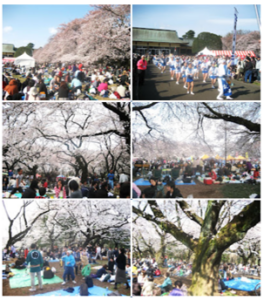
Welcome Princess Irene
On the 5th January, 2010 Princess Irene visited our Saitama Depot from the Uganda Embassy.
In December of last year, Mr. Yamada of our company met with her royal highness at the Uganda Embassy in Tokyo. At present, the Republic of Uganda is experiencing rapid development and as a result both traffic jams and road accidents are frequently occurring. One cause of such accidents is the excise use of ‘MATATU’ as public transportation. (10-15 seater, minibuses, the Toyota Hiace and the Nissan Caravan are frequently used as MATATU)
It is believed that replacing these Matatu with larger route buses running regular routes would do much to ease traffic conditions. Our company is a specialist retailer and supplier of microbuses and medium class buses.
It is also believed that the introduction of Japanese driving school vehicles equipped with dual controls and additional mirrors would contribute to the training of responsible driver. This, in turn would help reduce the number of accidents. Following Mr. Yamada’s presentation, her Royal Highness expressed great interest in our company’s services. A few days later, her Royal Highness graciously came to our depot in Saitama to view our large buses, microbuses and driving school vehicles including our Toyota Comforts and Mitsubishi Lancers.
We take pride in our good relations with the Republic of Uganda and enjoy a great deal of mutual trust.
We miss you Mr.Godfrey S Simasiku
He finished his term in Japan and returned to Zambia on 4th August 2009.
The Zambian ambassador Mr.Godfrey S Simasiku returned home in May. He came to Japan in September 2002 and for 7 years worked for a good relationship between Japan and Zambia. He visited our company depot and was very interested in our stock of minibuses and microbuses for use in Zambia. He very kindly introduced us to contacts in Zambia and gave us valuable business advice for which we are very grateful.
We wish him good luck on his return to Zambia.
Thank you very much.

Memories in Cambodia
Buntheng Orchard
Parental home of Mr. Buntheng who is now studying in Japan.
Owner of the Orchard is his father, Mr. Cheav, Buntheng
who recently retired from a government office and bought a farm
land of 35 hectares five years ago, planted thousands of Mango
and Jack Fruit trees, seems enjoying his retired life reluctantly.
We were treated with Cambodian foods at his guest house on hill in
the orchard. Despite Cambodian weather exceeding 30 C everyday,
being spent with a comfortable time.
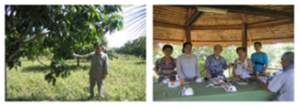
Sihanouk Ville (Port of Kampong Som )
International Sea Port was constructed by Japanese ODA,
There are several beautiful beaches in Sihanouk Ville
but the most popular and developed one is O Chheu Teal beach.
Resort in nature and having delux hotels, reasonable guest houses
and restaurants, etc. It is safe, it’s a kind of city would like to live a few months.


Bus Terminal (Phnom Penh )
From here long distance buses go to Siem Reap, Sihanouk Ville and
Ta Kev and its ride fare differs from US$3 to $5 equivalent local
currency, depending on seasons and a kind of bus you ride.
Some buses even provide meals and washing hot towels to passengers.
At any rate, travelllers are not in hurry.



New Sai Travel (Siem Reap )
A trave company uses our exported buses are operated and it has
many Japanese staff. They are very kind and providing us with delicate
service to any traveller. If you are thinking about a tour to Cambodia.
Why not consult with them any time.
E-MAIL: saicam@online.com.kh TEL: 023-362-590
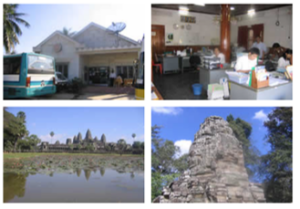
Kazumasa Mizue
President
Auto Galaxy Co., Ltd.
Memories in Zambia
Visit of the ambassador of Zambia to our stock yards
Upon request of the Hospital Union in Zambia, the ambassador of Zambia visited to our stock yards to see the vehicles to be chosen.
He asked us a lot of questions about buses, micro buses, minibuses, trucks and sedan cars.
It sometimes happens that payment made but no vehicle arrived!

At Maysair Hotel in Kenya.
It was a group of Mr.Muskari Kombo,a minister of the state, Kenya.
One of his attache told me to take a commemorative picture with him so I did it without any hesitation.
The minister immeidately knew that I was a Japanese and became so friendly to me.
As frequently reported by the Japanese press. I strongly felt that Kenya and Japan are good friends.

“MUMBWA TOWN
Mr. Masama who lives in a town of neither telephone nor electricity,
270 kilo meters away from Lusaka and he runs a big farm and comes to Lusaka once a month to buy his necessities.
I don’t Know why he always carries an umbrella. Might be the weather in Zambia changeable?
His shopping is quite rough.
This time he bought with us two Toyota Corona Diesels and two Honda motor bikes CB400.

Japanese Used Truck
Proud of their truck of 6 tons bought from Auto Galaxy!
They will modify its bed of consignor to be loaded more corn and wheat.
People work hard! We will buy another one soon!

Japanese Used Vehilces
A good quality micro buses bought from Japan. a used car dealer, Auto Galaxy (second one from the left and the second one from the right) “29 seater, Mitsubishi Rosa” runs through the country of Zambia to be as a country’s means of transportation.

Bus Terminal in Lusaka.Capital City of Zambia
On December 30th,2003.after buying a lot of gifts like Japan they will go back to their families by long distance bus for spending New Year’s Holidays.
Their destination might be either Lubumba or Kafue. National roads are clean and safe.

Kazumasa Mizue
President
Auto Galaxy Co., Ltd.